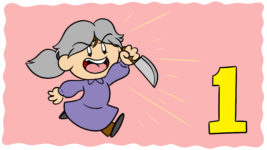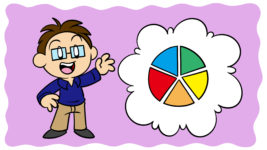A while back, we looked at how to use the enneagram to create complex and believable characters. Personality is a complicated thing, which is one reason personality tests exist. It’s also a reason why there are so many different types of personality tests.
One such test is the Myers-Briggs Type Indicator. This self-assessment questionnaire assesses how people make decisions, making it a powerful tool for exploring and developing your characters. This week, we’ll be taking a look at how you can use the Myers-Briggs test in your own writing.
Myers-Briggs basics
One of the best-known personality tests, Myers-Briggs measures four opposing pairs of characteristics – extraversion & introversion, sensing & intuition, thinking & feeling, and judging & perceiving.
Many authors are already familiar with the first of these distinctions – introverts’ energy is drained by being around people, and extraverts’ energy is replenished – and use these character types in their writing. Two introverts, however, might have very different ways of perceiving information. The first, let’s call her Jane, is an ‘N’ for intuition. She is more inclined to trust her intuitions, following her own hunches. The second, July, is an ‘S’ – a sensing type. She accepts as valid information she receives from the world through external cues. If you’ll forgive me for stereotyping, this is why you have introverts that are more like hippies (Jane) and those who are more like nerds (July). This is an obvious example, but the different MBTI preferences can show the way some personality traits layer over others to create radically different people that share some things in common.
Thinkers are logical, feelers are emotional. Judgers tend to stick to their plans, perceivers tend to roll with the punches. But none of these traits alone will predict how a character acts in the day-to-day. This is why an intuitive perceiver – someone who trusts himself a lot (intuition) but is also highly adaptive to the world (perceiving) is more likely to have ADHD characteristics. He is very resourceful and readily bored. The intuitive judger – who trusts herself and sticks to her choices – is probably going to be a CEO. She’s also a great problem-solver, but she’s less interested in multiple solutions and more in pushing forward the solution she already created. These two types may have everything else in common, but the influence of the final characteristic can result in drastically different responses to life, relationship capabilities, career paths, and more.
Myers-Briggs layers
Myers-Briggs preferences are inter-influential (as discussed above,) but they are also hierarchical. One preference typically has the strongest influence over a person (the ‘dominant’ preference,) then another (‘auxiliary’) and then the third (‘tertiary,’) and then the last (‘inferior.’) An ISFJ (introverted, sensing, feeling, judging) for who introversion is an inferior function may act like an extrovert much of the time. Relationships are important to sensing and feeling types, and judgers are fiercely loyal. If that ‘I’ isn’t very strong, you might have an introvert who spends a lot of time around people. If you look closer, they are very specific people (close friends and family,) but they’re so nice to everybody else that only members of their inner circle recognize their introversion. How different this looks from the miser or the bookworm, or someone for who ‘I’ is the dominant preference!
The different MBTI types are outlined here. The descriptions give you a pretty good idea of how the preferences inter-influence each other, but to really delve into your character’s psyche, ask which preferences are dominant and inferior.
So how does all this help my characters make decisions?
What MBTI calls ‘preferences’ are really ‘values’ by a different name. What a character (what a person!) values determines their choices. If someone values money more than family, they might sell a cousin out for a bribe or (in a less extreme world) choose to seek professional accomplishments over family stability. In this way, what a person thinks of as their values may not be the values that actually guide their choices.
This concept (which I discussed in How To Identify A Character’s Super Objective) is the pivot of much insightful and popular fiction. In crime drama Breaking Bad, the protagonist initially claims to be engaging in criminal acts for his family, but he eventually admits it was about feeling powerful, while in Hamlet, the protagonist commits to a murder that runs counter to his true nature and then spends most of the story trying to either postpone it or persuade himself it’s necessary. In both these stories, the protagonists’ choices don’t make sense if you accept the values they claim to have, but their writers knew their actual motivations, and their stories are richer for that understanding.
Which of the MBTI preferences dictate how your characters respond to conflict and stress? Are their choices under pressure different than in the day-to-day? Understanding the way preferences interact and dominate can help you answer these questions. Here’s a case study: INFP. Introverted, intuitive, feeling, perceiving. These types are loyal, adaptive, and empathetic. Their beliefs are important to them, as are their ‘people.’ They’re introverted, but this character trait may play out differently under different circumstances and different levels of stress. In the everyday, an example of this type is in touch with her emotions, but her beliefs come from within, so she isn’t emotionally erratic and doesn’t need a ton of external affirmation. She probably keeps to herself more than average, but if a friend needs her, she will unhesitatingly leave her comfort zone to help. Despite this, if a friend asks her to go against something she believes in, she will stand her ground. If something forces her to go against one of her own values, this might be the testing point or even breaking point for a character of this type.
However, if our INFP is P-dominant and N-inferior, his intuitions (N – internal beliefs) are less powerful. His perceptions (P) make him curious and flexible. While he might hold to his values under normal circumstances, the stress factors that so dramatically affected his N-dominant friend above may not bother him as much. They may even provide an interesting learning experience.
Putting Myers-Briggs into practice
There are a number of steps you can take to start using the Myers-Briggs in character formation and decision making.
The first (and you must have seen this coming) is to take the test yourself. If you don’t know your type and preferences, you don’t know what bias you’re taking to the page. Without extreme intentionality, our characters tend to reflect our biases. We can’t guard against this without knowing what they are. Taking the test also provides insight into how the test works and what the results say about a person. In addition, the questions, by asking you to make decisions, give you raw material for your characters’ everyday lives. ‘Well, if I’m a J and my protagonist is a P, and I answered this question “no,” they would probably answer “yes,” which means XYZ for my plot twist in this chapter.’
The second is to explore the personality types. Get to know them. Google additional resources. Find the types that best match your characters, or that you’d like to use for characters, and become intimately acquainted with these types’ quirks and habits, manifestations and anomalies. You want to know the types so well that you don’t have to ask mundane questions like, ‘Would my character eat a bowl of cereal on a day like today?’ – not because the question is insignificant but because you already know the answer. No character decision, however small, is insignificant. The decisions they make, the values they hold, show who they are as people. If they break from who they are, they become untrustworthy or – worse – unconvincing.
The third is to interview people who are either opposite you (you’re an E and they’re an I) or who have similar traits but stronger or weaker manifestations of those traits. If you are a perceiver, and one of your characters is a judger, don’t try to write that character without talking to a judger. Their reception of and response to the world is going to be so unpredictably different from yours that, most of the time, you can’t imagine their response until you learn it. People’s different decisions (and decision-making processes) are such an important part of conflict, conflict resolution, relationships, and real-life plots.
Finally, ask how small and major stresses will affect your characters according to their type. If you’ve done your homework in step two, you should be able to pick out who will buckle under pressure and who will stand. You’ll know your characters’ values and where they draw the line. If a character feels flat, unbelievable, or overly stressed, check that they are making choices that are congruent with their values.
Hopefully my musings on the Myers-Briggs have given you something to chew on. Have you used personality tests before to shape your characters? Tell me about your successes (and failures) in the comments, and check out Psychology 101: Knowledge That Will Improve Your Writing and Character Alignment Can Improve Your Book With A Simple Grid for more great advice on this topic.






2 thoughts on “How To Use Myers-Briggs Types To Help Your Characters Make Decisions”
I have not used personality types from psychology tests but I did use Celtic tree signs according to which personality is governed by the time of year someone was born. I called my characters Holly and Willow etc. I have not finished that story and became a little bogged down by the limitations that restricted the actions of the characters. I will return to it. I am at the point where the situation is a real mess and I need to solve the problems. I have begun to do so. The character who could get the situation right is not the protagonist. Meanwhile, I am still writing in a Celtic mythology-based world so I feel that when I get back to it I may have some new ideas based on what I have learnt.
After reading this article I am worried that in the novel I am writing, some of my characters do not come over as distinct enough in personality, although their roles are clear and they have their own personal goals. They do not think like me but are superstitious. I had hoped to deal with it later by making their speech styles different.
Thank you for the food for thought, it helps to keep me on my toes.
Hi, Rosamund.
Celtic tree signs – what a great idea! I can see how personality types might blur together in a world like that; might be a good idea to run the characters through a personality test, or at least dig into the type descriptions a bit. Making their speech styles different is a good tack, you may just want to spend some time chatting with people who reflect your characters’ personality types to pick up on possible quirks and mannerisms.
Best wishes,
Rebecca